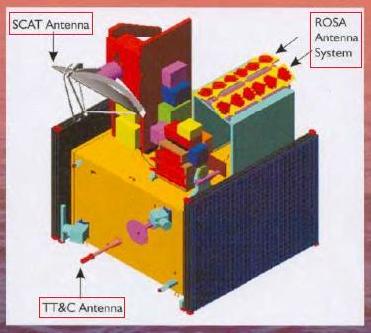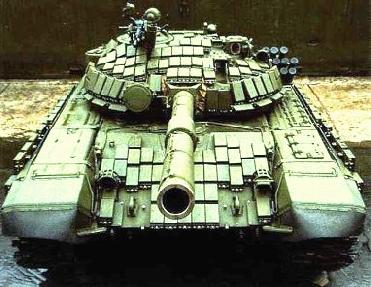
Graphical representation of Oceansat-2 configuration. Image Credit: ISRO
Oceans, occupying almost 70% of the earth's surface, greatly influence the global climate affecting the economy and day-to-day life of the people. Studying the nature of influence of oceans and its role in shaping the Earth's environment has always been a scientific priority.
The traditional and conventional methods of study through observations using ships, buoys, etc are both difficult and expensive. Thus, to acquire advanced observations of the physical and biological parameters of the oceans, space borne sensors are an absolute must.
On May 1999, the Indian Remote Sensing (IRS) programme of ISRO launched IRS-P4 (Oceansat-1). It was the first dedicated mission for applications pertaining to ocean studies and meteorology. Two major payloads- Ocean Colour Monitor (OCM) Multi-frequency Scanning Microwave Radiometer (MSMR) were flown on-board IRS-P4. The data from OCM is being routinely used for identification of potential fishing zones in the Arabian Sea and Bay of Bengal.
Oceansat-1 is at present studying the Earth's environment and is actively involved in studying the Ocean. After Oceansat-1, ISRO is now ready to launch Oceansat-2 in mid-September 2009.
Oceansat-2 which is ISRO's second in the series of Indian Remote Sensing (IRS) satellites is dedicated to ocean research. OceanSat-2 is envisaged to provide continuity to the services and applications of the Oceansat-1 Ocean Colour Monitor (OCM) data along with additional data from a Ku-band pencil beam Scatterometer and Radio Occultation Sounder for the Atmosphere (ROSA) sensors.
Oceansat-2 is a three axis body stabilised spacecraft which will be placed into a near circular sun-synchronous orbit, at an altitude of 720 Km, with an equatorial crossing time of around 1200 hrs. The orbital period is 99.31 minutes and the repetitive cycle is 2 days.
The main objectives of OceanSat-2 are to study surface winds and ocean surface strata, observation of chlorophyll concentrations, monitoring of phytoplankton blooms, study of atmospheric aerosols and suspended sediments in the water.
Oceansat-2 will carry three scientific payloads including an Ocean Colour Monitor (OCM-2), similar to the device carried on Oceansat-1. Out of three payloads, two are Indian and one is from Italian Sapce Agency.
Ocean Colour Monitor (OCM) provides an instantaneous geometric field of view of 360 meter and a swath of 1420 km. Scanning Scatterometer (SCAT) is an active microwave device designed and developed at ISRO/SAC, Ahmedabad which will be used to determine ocean surface level wind vectors through estimation of radar backscatter. And finally, Radio Occultation Sounder for Atmospheric Studies (ROSA) is a new GPS occultation receiver provided by ASI (Italian Space Agency). The objective is to characterise the lower atmosphere and the ionosphere, opening the possibilities for the development of several scientific activities exploiting these new radio occultation data sets.
Data from these payloads will aid research in oceanographic and atmospheric science.
With the realisation of the Oceansat-2 Mission, India would have the wherewithal to cover many applications pertaining to the ocean and meteorology. Among these applications, fisheries, coastal zone mapping, ocean process studies, inputs for operational numerical weather prediction, ocean state forecasting, input to ocean models as well as for the tropical cyclone monitoring and prediction are likely to get a further boost.
- Courtesy: ISRO.
 Previous Article
Previous Article Next Article
Next Article












The Indian Air Force, in its flight trials evaluation report submitted before the Defence Ministry l..
view articleAn insight into the Medium Multi-Role Combat Aircraft competition...
view articleSky enthusiasts can now spot the International Space Station (ISS) commanded by Indian-American astr..
view article